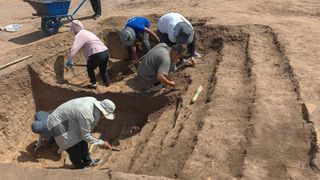Researchers in China have discovered a jade dragon within a 5,000-year-old tomb.
The artifact is 6.2 inches long and 3.7 inches wide (15.8 by 9.5 centimeters) and was found within a circular tomb that has a square altar just south of it, the official state news agency Xinhua reported. Human remains were also found in the tomb, along with a large amount of pottery including cups, basins and pots in the shape of tripods.
The tomb, located in the city of Chifeng in the Inner Mongolia Autonomous Region in China, is between 5,000 and 5,100 years old, dating to a time when the Hongshan culture flourished in the region. The people of this Neolithic culture grew crops, built sizable towns with large buildings and created intricate artifacts. The new find is the biggest example of a jade dragon created by the Hongshan culture ever discovered, Xinhua reported.
While the discovery is "very nice it is not that unique," Gideon Shelach-Lavi, a professor of East Asian Studies at The Hebrew University of Jerusalem, told Live Science in an email. Shelach-Lavi has excavated at Chifeng in the past but was not involved with the new discovery.
Related: 800-year-old healing bowl emblazoned with double-headed dragon unearthed in Turkish castle

—Lavish 2,200-year-old tomb unearthed in China may be that of ancient king
—1,400-year-old tomb of emperor in China reveals evidence of royal power struggle among brothers and a warlord
—Ancient people in Taiwan yanked healthy teeth from their mouths for 'aesthetic expression' and 'tests of courage,' study finds
He noted that jade dragon artifacts of similar size have been discovered in the past at other Hongshan culture tombs. He also noted that researchers can't be certain the newly found jade dragon, or the previously found ones, actually depict dragons. "We do not really know what their meaning was during the Neolithic period so calling them 'dragons' is anachronistic," Shelach-Lavi said.
The location where the artifacts and human remains were found is more than a tomb. "It is a ritualistic structure that contains, among other things, graves of specific individuals," Shelach-Lavi said. He noted that similar structures were found in previous excavations at another site called Niuheliang.
Sign up for the Live Science daily newsletter nowGet the world’s most fascinating discoveries delivered straight to your inbox.
By submitting your information you agree to the Terms & Conditions and Privacy Policy and are aged 16 or over.Live Science contacted archaeologists who made the new discovery at Chifeng but did not hear back at time of publication.